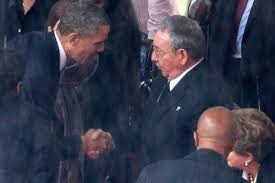(VOVworld) – US President Barack Obama shook hands with Cuban President Raul Castro at Nelson Mandela’s memorial service in South Africa. Although it’s a symbolic gesture, can the cordial handshake be a historic milestone that signals a thaw in a relationship that has been frozen for the past 50 years?

US President Barack Obama shakes hands with Cuban President Raul Castro at Nelson Mandela’s memorial service in South Africa on Dec 10. (photo: news.yahoo.com) |
Before delivering a speech in praise of former South African President Nelson Mandela’s career and legacy at a memorial service on December 10, US President Barack Obama stopped briefly to shake hands with Cuban President Raul Castro. The two leaders exchanged pleasant smiles in front of 100 world leaders gathered to honor Mandela. The gesture between the leaders of two adversary nations surprised the public. It’s just the second handshake between the leaders of the US and Cuba since the Cuban revolution in 1960.
Ice thawing
Conflict has typified the relationship of the two countries, which are separated by just 140 km of water. Since 1961, the US has imposed a strict blockade and sanctions on Cuba, which is said to have caused losses as high as 1.1 trillion USD to Cuba’s economy. The US sanctions have prevented Cuban people from accessing health services to treat fatal diseases.
Recently, it’s not difficult to recognize that the two nations are secretly moving closer to each other. The most visible sign is their careful response to other’s problems. In the diplomatic tension between the US and other countries after Edward Snowden leaked secrete US intelligence gathered by the NSA, Cuba refused Snowden asylum. The US and Cuba both dealt quietly with a North Korean cargo ship transporting weapons from Cuba to Panama in violation of UN regulations. These actions are not what would have been done in the past.
Initial steps to move from foes to partners
Since taking office, President Obama has been committed to talking with all adversary countries. He has made several adjustments to ease tensions with Havana, including lifting restrictions on travel and remittances to Cuba and resuming negotiations on postal services and immigration. Early this year, the US allowed a convicted Cuban spy to return home. The US praised Cuba’s role in organizing peace conferences between the Revolutionary Armed Forces of Colombia and the Colombian government. These developments have ignited a rumor that Washington will remove Cuba from the list of terrorism-supporting countries. In October, after 188 of the 192 UN members adopted a resolution condemning the US sanctions on Cuba over the past 50 years, President Obama said the US will amend its policy towards Cuba.
President Raul Castro has gained a reputation as a reform leader since he replaced his brother Fidel in 2008. Reforms in opening markets and unifying the currency have changed Cuba. Economic reform is expected to breathe new vitality into Cuba and open opportunities for international economic ties, especially with the US. The US has closely observed the changes in Cuba.
It’s too early to conclude that the cordial handshake between Obama and Castro will finally thaw the US-Cuba relationship. Obama is already under pressure and drawing criticism for seeking a breakthrough in relations with Iran. His effort to improve relations with Cuba may stop at this beginning stage. He may face opposition from the Senate where Democrats senators insist that the US should maintain limited ties with Cuba. Obama’s hope of turning a foe into a partner may never been realized.